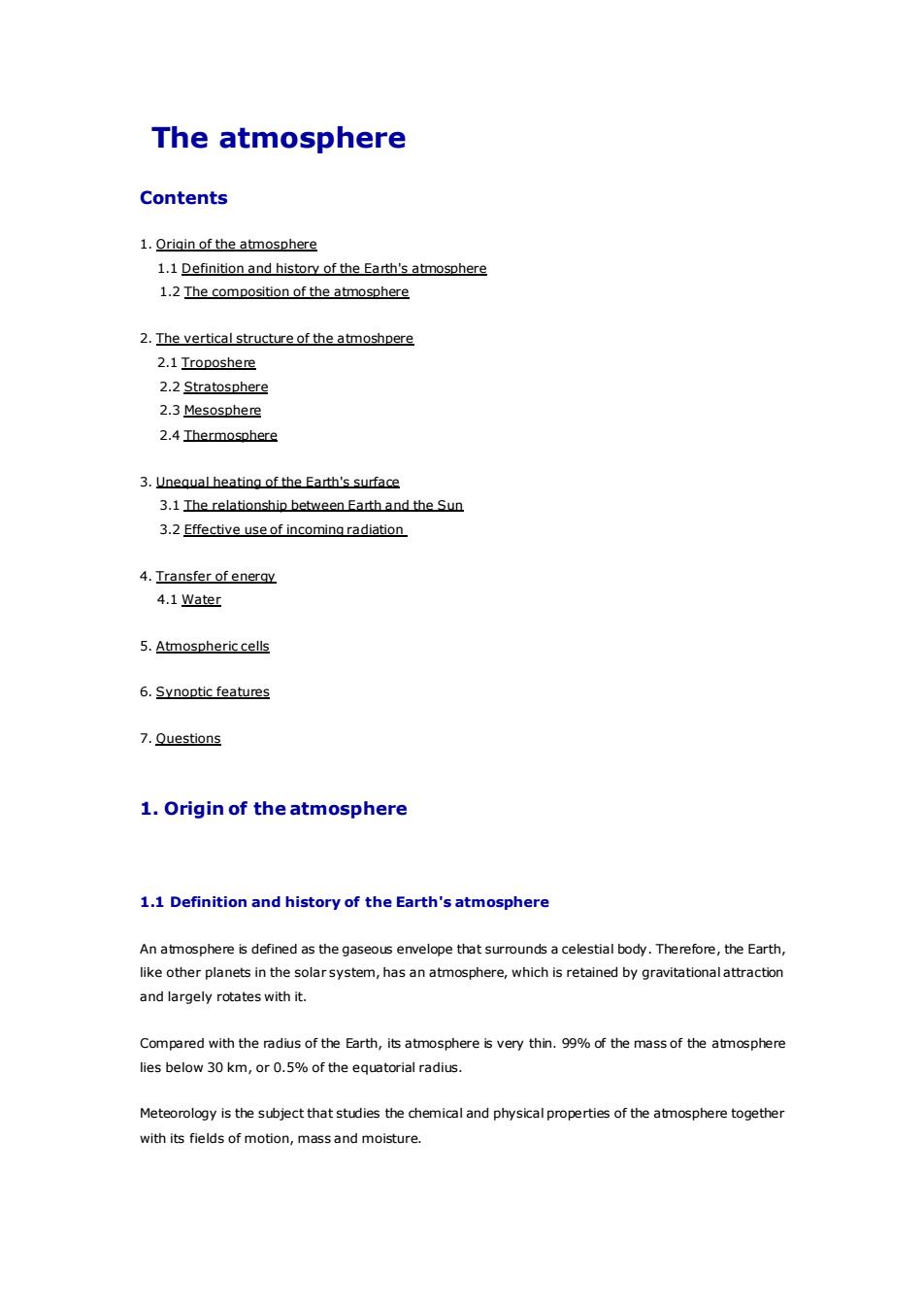
The atmosphereContents1. Oriqin of the atmosphere1.1Definitionand historyof theEarth's atmosphere1.2The composition of theatmosphere2. The vertical structure of the atmoshpere2.1 Troposhere2.2 Stratosphere2.3Mesosphere2.4Thermosphere3. Unequal heating of the Earth's surface3.1TherelationshipbetweenFarthandtheSun3.2Effective use of incoming radiation4.Transferofeneray4.1 Water5. Atmospheric cells6.Synopticfeatures7.Questions1.Originof theatmosphere1.1DefinitionandhistoryoftheEarth'satmosphereAn atmosphere is defined as thegaseous envelope that surrounds a celestial body.Therefore,the Earth,likeotherplanets in the solarsystem,hasan atmosphere,which is retained bygravitationalattractionand largely rotates with it.Compared with the radius of the Earth, its atmosphere is very thin. 99% of the mass of the atmosphereliesbelow30km,or0.5%oftheequatorialradiusMeteorology is the subject that studies the chemical and physical properties of the atmosphere togetherwith its fields ofmotion,massandmoisture
The atmosphere Contents 1. Origin of the atmosphere 1.1 Definition and history of the Earth's atmosphere 1.2 The composition of the atmosphere 2. The vertical structure of the atmoshpere 2.1 Troposhere 2.2 Stratosphere 2.3 Mesosphere 2.4 Thermosphere 3. Unequal heating of the Earth's surface 3.1 The relationship between Earth and the Sun 3.2 Effective use of incoming radiation 4. Transfer of energy 4.1 Water 5. Atmospheric cells 6. Synoptic features 7. Questions 1. Origin of the atmosphere 1.1 Definition and history of the Earth's atmosphere An atmosphere is defined as the gaseous envelope that surrounds a celestial body. Therefore, the Earth, like other planets in the solar system, has an atmosphere, which is retained by gravitational attraction and largely rotates with it. Compared with the radius of the Earth, its atmosphere is very thin. 99% of the mass of the atmosphere lies below 30 km, or 0.5% of the equatorial radius. Meteorology is the subject that studies the chemical and physical properties of the atmosphere together with its fields of motion, mass and moisture
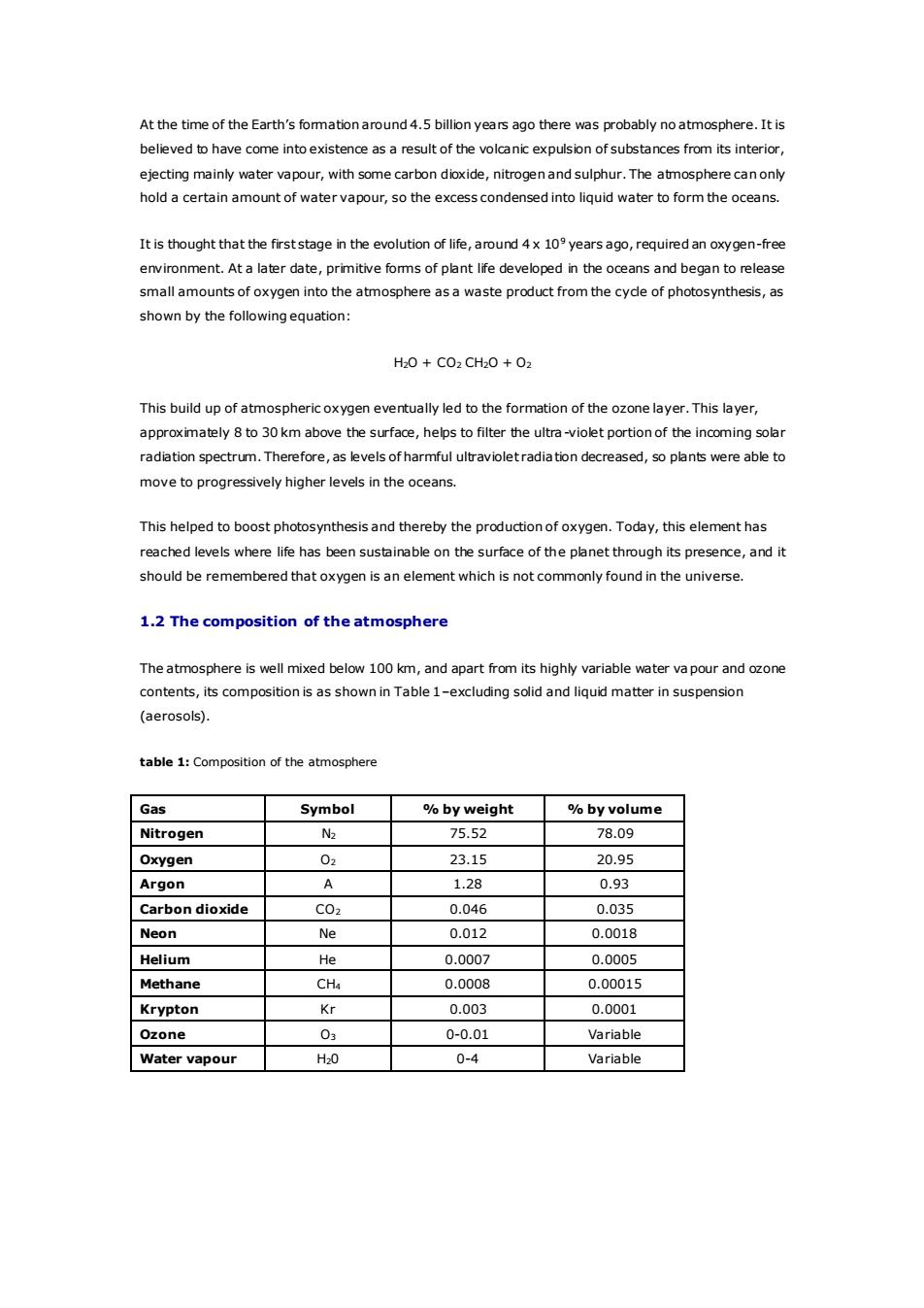
AtthetimeoftheEarth'sfomationaround4.5billionyearsagotherewasprobablynoatmosphere.Itisbelieved to have come into existence as a result of the volcanic expulsion of substances from its interior,ejecting mainly water vapour, with some carbon dioxide, nitrogen and sulphur. The atmosphere can onlyholdacertainamountofwatervapour,sotheexcesscondensedinto liquidwatertoformtheoceansIt is thought that the first stage in the evolution of life,around 4x 10° years ago,required an oxygen-freeenvironment. At a later date, primitive forms of plant lfe developed in the oceans and began to releasesmallamounts of oxygen into the atmosphere as a waste productfrom the cydle of photosynthesis,asshown by the following equation:H20 + CO2 CH20+ O02This build up of atmospheric oxygen eventually led to the formation of the ozonelayer.This layer,approximately 8 to 30 km above the surface, helps to filter the ultra -violet portion of the incoming solarradiation spectrum.Therefore,as levels ofharmful ultravioletradiation decreased, so plants were able tomovetoprogressivelyhigherlevelsintheoceansThis helped to boost photosynthesis and thereby the production of oxygen.Today,this element hasreached levels where life has been sustainable on the surface ofthe planet through its presence,and itshould be remembered that oxygen is an element which is not commonlyfound in the universe.1.2ThecompositionoftheatmosphereTheatmosphereiswell mixedbelow1ookm,andapartfrom itshighlyvariablewatervapourandozonecontents,its composition isas shown inTable1-excluding solidand liquid matter in suspension(aerosols).table1:CompositionoftheatmosphereGasSymbol%byweight%byvolumeN2Nitrogen75.5278.09oxygen0223.1520.95A1.280.93ArgonCO20.0460.035CarbondioxideNeNeon0.0120.0018HeHelium0.00070.0005CH40.00080.00015MethaneKr0.0001Krypton0.003Ozone030-0.01Variable0-4H20 VariableWatervapour一
At the time of the Earth’s formation around 4.5 billion years ago there was probably no atmosphere. It is believed to have come into existence as a result of the volcanic expulsion of substances from its interior, ejecting mainly water vapour, with some carbon dioxide, nitrogen and sulphur. The atmosphere can only hold a certain amount of water vapour, so the excess condensed into liquid water to form the oceans. It is thought that the first stage in the evolution of life, around 4 x 109 years ago, required an oxygen-free environment. At a later date, primitive forms of plant life developed in the oceans and began to release small amounts of oxygen into the atmosphere as a waste product from the cycle of photosynthesis, as shown by the following equation: H2O + CO2 CH2O + O2 This build up of atmospheric oxygen eventually led to the formation of the ozone layer. This layer, approximately 8 to 30 km above the surface, helps to filter the ultra-violet portion of the incoming solar radiation spectrum. Therefore, as levels of harmful ultraviolet radiation decreased, so plants were able to move to progressively higher levels in the oceans. This helped to boost photosynthesis and thereby the production of oxygen. Today, this element has reached levels where life has been sustainable on the surface of the planet through its presence, and it should be remembered that oxygen is an element which is not commonly found in the universe. 1.2 The composition of the atmosphere The atmosphere is well mixed below 100 km, and apart from its highly variable water vapour and ozone contents, its composition is as shown in Table 1–excluding solid and liquid matter in suspension (aerosols). table 1: Composition of the atmosphere Gas Symbol % by weight % by volume Nitrogen N2 75.52 78.09 Oxygen O2 23.15 20.95 Argon A 1.28 0.93 Carbon dioxide CO2 0.046 0.035 Neon Ne 0.012 0.0018 Helium He 0.0007 0.0005 Methane CH4 0.0008 0.00015 Krypton Kr 0.003 0.0001 Ozone O3 0-0.01 Variable Water vapour H20 0-4 Variable
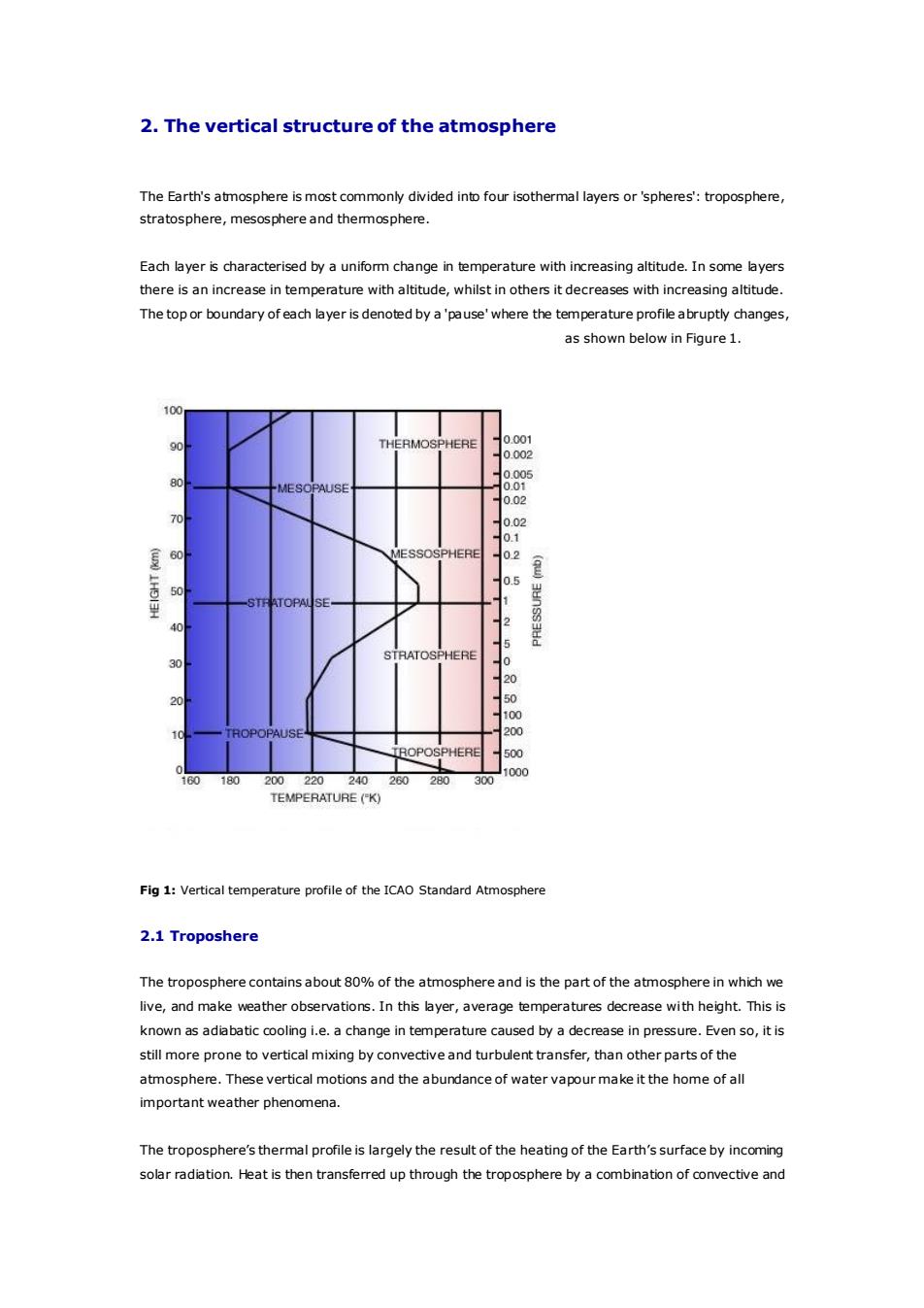
2.TheverticalstructureoftheatmosphereThe Earth's atmosphere is most commonly divided into four isothermal layers or'spheres': troposphere,stratosphere,mesosphereandthermosphere.Each layer is characterised by a uniform change in temperature with increasing altitude. In some layersthere is an increase in temperature with altitude, whilst in others it decreases with increasing altitude.The top or boundary of each layer is denoted by a'pause'where the temperature profile abruptly changes,as shownbelowinFigure1.1000.00190THERMOSPHERE0.0028.8080MESOPAUSE0.02700.02MESSOSPHERE0.26(qu)H0.550STEATOPALSE型240STRATOSPHEREo30205020100200TROPOPAUSE10500TROPOSPHERE11000160180200240220260280300TEMPERATURE (°K)Fig1:Verticaltemperatureprofileof theICAO StandardAtmosphere2.1 TroposhereThe troposphere contains about 80% of the atmosphere and is the part of the atmosphere in which welive, and make weather observations. In this layer, average temperatures decrease with height. This isknown as adiabatic cooling i.e. a change in temperature caused by a decrease in pressure. Even so, it isstill more prone to vertical mixing by convective and turbulenttransfer,than otherparts of theatmosphere.Thesevertical motions and the abundanceof water vapourmakeitthe homeof allimportantweatherphenomenaThe troposphere's thermal profile is largelythe result of the heating of the Earth's surfaceby incomingsolar radiation. Heat is then transferred up through the troposphere by a combination of convective and
2. The vertical structure of the atmosphere The Earth's atmosphere is most commonly divided into four isothermal layers or 'spheres': troposphere, stratosphere, mesosphere and thermosphere. Each layer is characterised by a uniform change in temperature with increasing altitude. In some layers there is an increase in temperature with altitude, whilst in others it decreases with increasing altitude. The top or boundary of each layer is denoted by a 'pause' where the temperature profile abruptly changes, as shown below in Figure 1. Fig 1: Vertical temperature profile of the ICAO Standard Atmosphere 2.1 Troposhere The troposphere contains about 80% of the atmosphere and is the part of the atmosphere in which we live, and make weather observations. In this layer, average temperatures decrease with height. This is known as adiabatic cooling i.e. a change in temperature caused by a decrease in pressure. Even so, it is still more prone to vertical mixing by convective and turbulent transfer, than other parts of the atmosphere. These vertical motions and the abundance of water vapour make it the home of all important weather phenomena. The troposphere’s thermal profile is largely the result of the heating of the Earth’s surface by incoming solar radiation. Heat is then transferred up through the troposphere by a combination of convective and
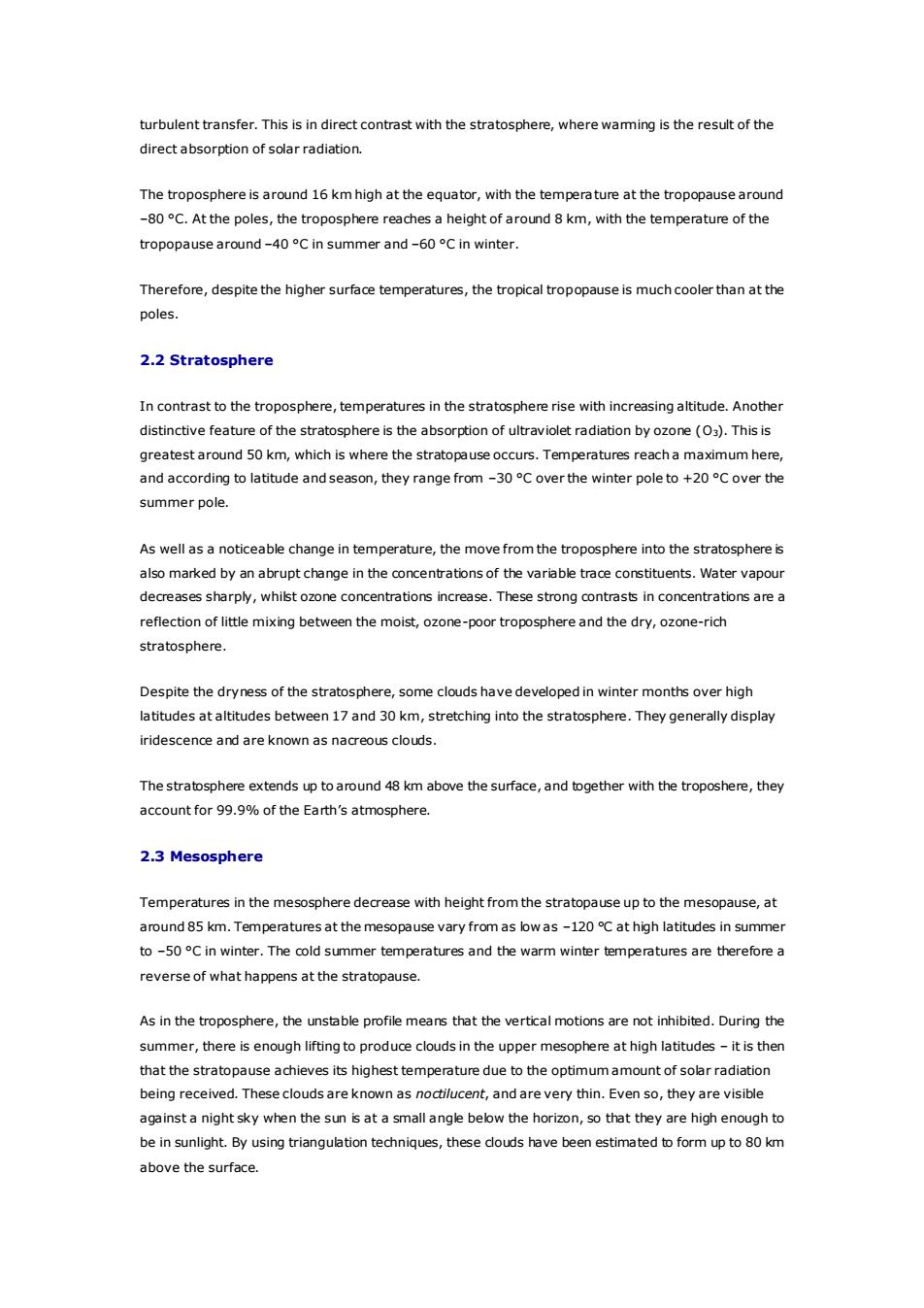
turbulent transfer.This is indirect contrast with the stratosphere, where waming is the result of thedirectabsorptionofsolarradiation.Thetroposphere isaround16kmhighattheequator,withthetemperatureatthetropopausearound-8oC.At thepoles,thetropospherereaches a heightof around8km,with thetemperatureofthetropopause around-40oC in summer and-60C in winter.Therefore, despite the higher surfacetemperatures,the tropical tropopause is muchcoolerthan at thepoles.2.2StratosphereIncontrasttothetroposphere,temperaturesinthestratosphererisewithincreasingaltitude.Anothedistinctivefeatureof thestratosphereis the absorption ofultraviolet radiationbyozone (O3).Thisisgreatest around 5o km, which is where the stratopause occurs. Temperatures reacha maximum here,and according to latitude andseason,they range from-30oC overthewinter pole to+20 Cover thesummerpole.As well as a noticeable change in temperature, the movefrom the troposphere into the stratosphere isalso marked by an abrupt change in the concentrations of the variable trace constituents.Water vapourdecreasessharply,whilstozoneconcentrations increase.Thesestrongcontrastsinconcentrationsareareflection of littie mixing between themoist,ozone-poor troposphere and the dry,ozone-richstratosphere.Despite the dryness of the stratosphere, some clouds have developedin winter months over highlatitudes ataltitudesbetween17and 30km,stretching into the stratosphere.Theygenerallydisplayiridescenceand areknownas nacreous clouds.Thestratosphere extends uptoaround 48km above the surface,and together with thetroposhere,theyaccountfor99.9%oftheEarth'satmosphere.2.3MesosphereTemperatures in the mesosphere decrease with heightfromthe stratopause up to the mesopause,ataround 85km.Temperatures atthemesopause varyfromas lowas-120 C at high latitudes in summerto -5o Cin winter.The cold summer temperatures and the warm winter temperatures are therefore areverseofwhathappensatthestratopause.As in the troposphere, the unstable profile means that the vertical motions are not inhibited. During thesummer,there is enough liftingto produce cloudsintheupper mesophere at highlatitudes-itis thenthatthestratopauseachievesitshighesttemperatureduetotheoptimumamountofsolarradiationbeing received. These clouds are known as noctilucent,and arevery thin. Even so,they are visibleagainst a night sky when the sun is at a small angle below the horizon, so that they are high enough tobe in sunlight. By using triangulation techniques, these clouds have been estimated to form up to 80 kmabovethe surface
turbulent transfer. This is in direct contrast with the stratosphere, where warming is the result of the direct absorption of solar radiation. The troposphere is around 16 km high at the equator, with the temperature at the tropopause around –80 °C. At the poles, the troposphere reaches a height of around 8 km, with the temperature of the tropopause around –40 °C in summer and –60 °C in winter. Therefore, despite the higher surface temperatures, the tropical tropopause is much cooler than at the poles. 2.2 Stratosphere In contrast to the troposphere, temperatures in the stratosphere rise with increasing altitude. Another distinctive feature of the stratosphere is the absorption of ultraviolet radiation by ozone (O3). This is greatest around 50 km, which is where the stratopause occurs. Temperatures reach a maximum here, and according to latitude and season, they range from –30 °C over the winter pole to +20 °C over the summer pole. As well as a noticeable change in temperature, the move from the troposphere into the stratosphere is also marked by an abrupt change in the concentrations of the variable trace constituents. Water vapour decreases sharply, whilst ozone concentrations increase. These strong contrasts in concentrations are a reflection of little mixing between the moist, ozone-poor troposphere and the dry, ozone-rich stratosphere. Despite the dryness of the stratosphere, some clouds have developed in winter months over high latitudes at altitudes between 17 and 30 km, stretching into the stratosphere. They generally display iridescence and are known as nacreous clouds. The stratosphere extends up to around 48 km above the surface, and together with the troposhere, they account for 99.9% of the Earth’s atmosphere. 2.3 Mesosphere Temperatures in the mesosphere decrease with height from the stratopause up to the mesopause, at around 85 km. Temperatures at the mesopause vary from as low as –120 °C at high latitudes in summer to –50 °C in winter. The cold summer temperatures and the warm winter temperatures are therefore a reverse of what happens at the stratopause. As in the troposphere, the unstable profile means that the vertical motions are not inhibited. During the summer, there is enough lifting to produce clouds in the upper mesophere at high latitudes – it is then that the stratopause achieves its highest temperature due to the optimum amount of solar radiation being received. These clouds are known as noctilucent, and are very thin. Even so, they are visible against a night sky when the sun is at a small angle below the horizon, so that they are high enough to be in sunlight. By using triangulation techniques, these clouds have been estimated to form up to 80 km above the surface
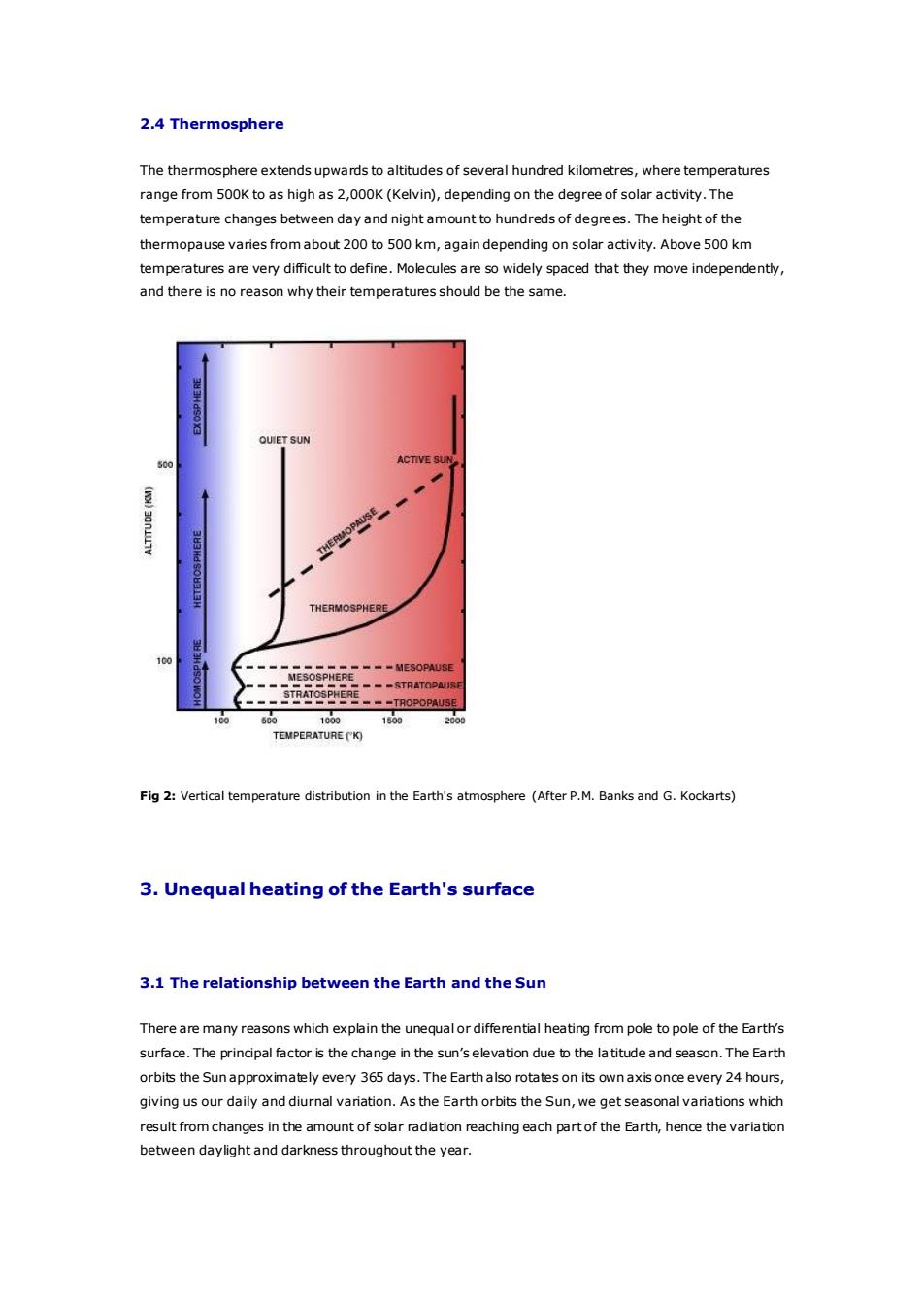
2.4 ThermosphereThethermosphereextendsupwardstoaltitudesofseveralhundredkilometres,wheretemperaturesrangefrom500Ktoashighas2,000K(Kelvin),dependingonthedegreeofsolaractivity.Thetemperaturechangesbetweendayandnightamounttohundredsofdegrees.Theheightofthethermopausevariesfromabout 200to50okm,againdependingonsolaractivity.Above500kmtemperatures are very difficult to define. Molecules are so widely spaced that they move independently,and there is no reason whytheirtemperaturesshould bethe same.ESOUIETSUNACTIVESU500)TOPAUSE_THERMORSOBEERTHERMOSFEO100ESOPAUSEMESOSPHERESTRATOPAUSSTRATOSPHEREC500100010015002000TEMPERATURE(K)Fig 2: Vertical temperature distribution in the Earth's atmosphere (After P.M. Banks and G. Kockarts)3.UnequalheatingoftheEarth'ssurface3.1TherelationshipbetweentheEarthandtheSunThere are many reasons which explain the unequalor differential heating from pole to pole of the Earth'ssurface.Theprincipalfactor is the change in the sun'selevation dueto the latitudeand season.The EarthorbitstheSunapproximatelyevery365days.TheEarthalsorotatesonitsownaxisonceevery24hours,giving us our daily and diurnal variation. As the Earth orbits the Sun,we get seasonalvariations whichresult fromchanges in the amount of solar radiation reaching each partof the Earth, hence the variationbetweendaylightanddarknessthroughouttheyear
2.4 Thermosphere The thermosphere extends upwards to altitudes of several hundred kilometres, where temperatures range from 500K to as high as 2,000K (Kelvin), depending on the degree of solar activity. The temperature changes between day and night amount to hundreds of degrees. The height of the thermopause varies from about 200 to 500 km, again depending on solar activity. Above 500 km temperatures are very difficult to define. Molecules are so widely spaced that they move independently, and there is no reason why their temperatures should be the same. Fig 2: Vertical temperature distribution in the Earth's atmosphere (After P.M. Banks and G. Kockarts) 3. Unequal heating of the Earth's surface 3.1 The relationship between the Earth and the Sun There are many reasons which explain the unequal or differential heating from pole to pole of the Earth’s surface. The principal factor is the change in the sun’s elevation due to the latitude and season. The Earth orbits the Sun approximately every 365 days. The Earth also rotates on its own axis once every 24 hours, giving us our daily and diurnal variation. As the Earth orbits the Sun, we get seasonal variations which result from changes in the amount of solar radiation reaching each part of the Earth, hence the variation between daylight and darkness throughout the year